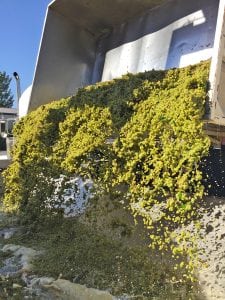
Home » State’s wine grape growers expect record harvest
State’s wine grape growers expect record harvest

September 16, 2016
By Wine News Service
If pre-harvest estimates hold up, Washington will crush a quarter-million tons of wine grapes this fall for the first time.
And if that takes place, the Washington wine industry will have effectively doubled in size in a decade.
Wine grape harvest kicked off in mid-August, making it one of the earliest starts ever, and grape growers throughout the Columbia Valley expect it to be a record crop, based on new acreage coming into production and a larger amount of fruit on the vines.
“This year’s crop is making up for two years of less-than-full production,” said Vicky Scharlau, executive director of the Washington Association of Wine Grape Growers, based in Cashmere. “Vines are expressing their full potential.”

Last year, Washington winemakers crushed 222,000 tons. That was the second most in state history, nearly reaching the record of 227,000 tons harvested in 2014. This year, growers expect to exceed 250,000 tons. Final wine grape harvest numbers typically are released in February.
In 2007, Washington harvested 127,000 tons. Thus, if the state tops 250,000 tons this year, it will have doubled in size in one decade.
Washington is the No. 2 wine-producing state in the country, a distant second to California. New York is No. 3, and Oregon is No. 4.
Fueling the growth is Ste. Michelle Wine Estates, Washington’s largest and oldest wine producer. The Woodinville-based company started in 1934, a few months after Prohibition was repealed. Ste. Michelle owns several top wineries, including Chateau Ste. Michelle, Columbia Crest, 14 Hands, Michelle Sparkling Wines and Snoqualmie.
Today, Ste. Michelle uses two out of every three grapes grown in Washington. And it is working with top grape growers to significantly increase vineyard acreage.
In 2006, Washington had about 31,000 acres of wine grapes statewide. By 2011, it was just shy of 44,000 acres. Last year, it was estimated to have 53,353 acres, according to the Washington Association of Wine Grape Growers. And this year, it has topped 56,000 acres. Most of these new vineyards are planted under contract with Ste. Michelle.
Typically, it takes three years for a newly planted vineyard to begin producing grapes. By the fifth year, it is considered to be in full production.
Most of the state’s growth is coming from the Horse Heaven Hills American Viticultural Area, a region south of the Yakima Valley that spans Benton and Klickitat counties.
“Our greatest area of growth has been in the Horse Heaven Hills,” said Kevin Corliss, vice president of vineyards for Ste. Michelle Wine Estates. “It has more capacity for growth.”
As recently as 2012, the Horse Heaven Hills had 3,769 acres of Cabernet Sauvignon, a red wine grape that is the No. 1 variety in the state. In 2013, that increased to 4,291 acres, then 4,714 acres in 2014. By last year, it had risen to 5,719 acres of Cabernet Sauvignon.
All of this growth greatly benefits Benton County, which is Washington’s No. 1 wine-producing county. Benton County wineries produce more than 40 percent of the wine in the state. It is home to such large producers as Columbia Crest in Paterson, 14 Hands in Prosser, Chateau Ste. Michelle’s red wine facility in Paterson, Hogue Cellars in Prosser, Pacific Rim in West Richland, Mercer Estates in Prosser, Hedges Cellars on Red Mountain, Powers Winery in Kennewick and Barnard Griffin in Kennewick.
According to a 2009 economic impact report, Benton County has the most wine-related jobs in the state at 3,170. King County is No. 2. Also in Benton County, nearly $43 million in state and local taxes are generated annually by the wine industry. Some of this comes from tourism. According to Visit Tri-Cities in Kennewick, more than 110,000 people come to the Tri-Cities for tourism, and being in the heart of wine country helps to draw more conventions and sports tournaments.
Solidifying Benton County as the hub of the wine industry is the Washington State University Wine Science Center in Richland, which is considered by industry experts as the most high-tech research and educational wine facility in the world. The $23 million Wine Science Center is just starting its second year of operation.
In mid-August, Rob Griffin of Barnard Griffin in Richland began his 40th harvest in Washington. He arrived in 1977 as head winemaker at Preston Wine Cellars north of Pasco. In 1983, he launched Barnard Griffin. He never expected to see such growth in the state’s wine industry.
“When I came up here, I thought I’d be here three or four years,” he said. “But by the time three or four years had gone by, I didn’t really see going back to California. There was just too much of interest up here.”
Local News
KEYWORDS september 2016




